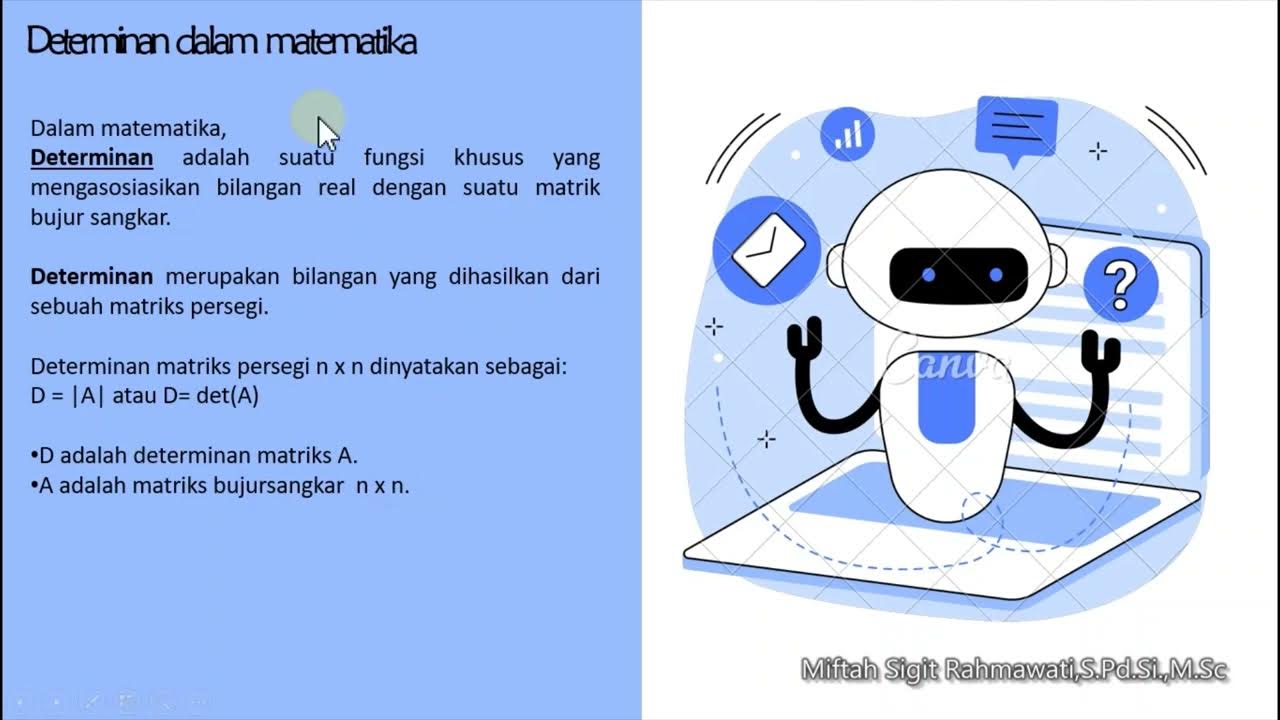Determinan Unung
Summary
TLDRIn this educational video on engineering mathematics, the instructor introduces the concept of determinants for square matrices. The lesson covers how to calculate determinants of order two and three using specific methods, such as the Sarrus rule. Various properties of determinants are discussed, including the effects of row exchanges, zero rows, and scalar multiplication. The video also explains how to use determinants in solving systems of linear equations through Cramer's rule, providing clear examples throughout. Concluding with a reminder for viewers to practice, the video aims to enhance understanding of these essential mathematical concepts.
Takeaways
- 📚 Determinants are scalar values associated with square matrices, representing key properties of the matrix.
- 🔢 The determinant of a 2x2 matrix can be calculated by multiplying the diagonal elements and subtracting the product of the other diagonal.
- 🧮 For a 3x3 matrix, the Sarrus method helps calculate the determinant by summing the products of diagonals.
- 🔄 Transposing a matrix (switching rows and columns) does not change the value of its determinant.
- ❌ If a matrix contains a row or column of zeros, its determinant is zero.
- 🔄 Swapping two rows or columns in a matrix will change the sign of the determinant.
- 🔢 The determinant of a triangular matrix is equal to the product of its diagonal elements.
- 🔍 Determinants can be used to solve systems of linear equations using Cramer's Rule.
- 🎲 The determinant of a matrix can be affected by multiplying a row by a scalar, where the determinant scales by that scalar.
- ✨ There are various properties of determinants, such as the effects of row operations and the impact of linear dependence on determinant values.
Q & A
What is a determinant in the context of square matrices?
-A determinant is a scalar value that can be computed from the elements of a square matrix. It is denoted as det(A) or |A| for a matrix A and provides important information about the matrix, such as whether it is invertible.
How is the determinant of a 2x2 matrix calculated?
-For a 2x2 matrix A = [[a11, a12], [a21, a22]], the determinant is calculated using the formula det(A) = a11 * a22 - a21 * a12.
What method is used to calculate the determinant of a 3x3 matrix?
-The determinant of a 3x3 matrix can be calculated using the Sarrus rule, which involves summing the products of the diagonals from the top left to the bottom right and subtracting the products of the diagonals from the bottom left to the top right.
What is the result of the determinant if a matrix has a row or column of zeros?
-If a square matrix has any row or column that consists entirely of zeros, its determinant is zero.
What happens to the determinant when two rows of a matrix are swapped?
-Swapping two rows of a matrix changes the sign of the determinant, effectively making it the negative of the original determinant.
How does multiplying a row by a scalar affect the determinant?
-If a row of a matrix is multiplied by a scalar k, the determinant of the new matrix is k times the determinant of the original matrix.
What is a transposed matrix and how does it relate to determinants?
-A transposed matrix is obtained by swapping rows and columns of the original matrix. The determinant of a matrix is equal to the determinant of its transpose, meaning det(A) = det(A^T).
What is the Cramer’s Rule in relation to solving systems of linear equations?
-Cramer’s Rule provides a method to solve a system of linear equations using determinants. It states that if a system has a unique solution, the values of the variables can be found by taking the determinants of modified coefficient matrices.
Can you explain the significance of the diagonal elements in a triangular matrix?
-For a triangular matrix (either upper or lower), the determinant is equal to the product of its diagonal elements. This property simplifies the calculation of determinants for triangular matrices.
What are the implications of having a determinant equal to zero?
-If the determinant of a matrix is zero, it implies that the matrix is singular, meaning it does not have an inverse and the corresponding system of equations has either no solution or infinitely many solutions.
Outlines

此内容仅限付费用户访问。 请升级后访问。
立即升级Mindmap

此内容仅限付费用户访问。 请升级后访问。
立即升级Keywords

此内容仅限付费用户访问。 请升级后访问。
立即升级Highlights

此内容仅限付费用户访问。 请升级后访问。
立即升级Transcripts

此内容仅限付费用户访问。 请升级后访问。
立即升级浏览更多相关视频

Determinan Part 1

Pengenalan data matriks array pada MATLAB

12th Maths Top 15 Confirm 5 Mark Questions - 12th Maths Half Yearly Important Questions 2024

Matrices in 10 Mins🔥😱 | Rapid Revision Class 12 Maths | Board Exams 2024-25 @allaboutmathematics

Matriks Matematika Kelas 11 • Part 1: Definisi / Pengertian Matriks & Jenis-Jenis Matriks

Aula 1 - Matrizes: Definição e Operações (Parte 1)
5.0 / 5 (0 votes)
